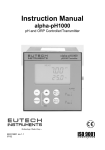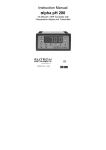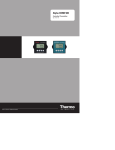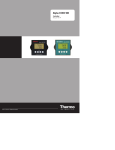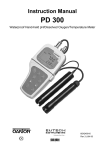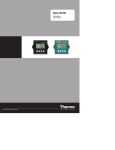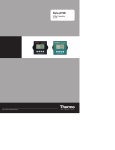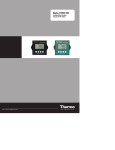Download EUTECH INSTRUMENTS ?lpha-pH550 Instruction manual
Transcript
Alpha pH 550 Monitor pH / ORP R AQUAfast, Cahn, ionplus, KNIpHE, No Cal, ORION, perpHect, PerpHecT, PerpHecTion, pHISA, pHuture, Pure Water, Sage, Sensing the Future, SensorLink, ROSS, ROSS Ultra, Sure-Flow, Titrator PLUS and TURBO2 are registered trademarks of Thermo Fisher. 1-888-pHAX-ION, A+, All in One, Aplus, AQUAsnap, AssuredAccuracy, AUTOBAR, AUTO-CAL, AUTO DISPENSER, Auto-ID, AUTO-LOG, AUTO-READ, AUTOSTIR, Auto-Test, BOD AutoEZ, Cable-Free, CERTI-CAL, CISA, DataCOLLECT, DataPLUS, digital LogR, DirectCal, DuraProbe, Environmental Product Authority, Extra Easy/Extra Value, FAST QC, GAP, GLPcal, GLPcheck, GLPdoc, ISEasy, KAP, LabConnect, LogR, Low Maintenance Triode, Minimum Stir Requirement, MSR, NISS, One-Touch, One-Touch Calibration, One-Touch Measurement, Optimum Results, Orion Star, Pentrode, pHuture MMS, pHuture Pentrode, pHuture Quatrode, pHuture Triode, Quatrode, QuiKcheK, rf link, ROSS Resolution, SAOB, SMART AVERAGING, Smart CheK, SMART STABILITY, Stacked, Star Navigator 21, Stat Face, The Enhanced Lab, ThermaSense, Triode, TRIUMpH, Unbreakable pH, Universal Access are trademarks of Thermo Fisher. Guaranteed Success and The Technical Edge are service marks of Thermo Fisher. Preface This manual serves to explain the use of the Alpha pH 550 Monitor. The manual functions in two ways, firstly as a step by step guide to help the user operate the instrument. Secondly, it serves as a handy reference guide. This instruction manual is written to cover as many anticipated applications of the Alpha pH 550 Monitor. If you have doubts in the use of the instrument, please do not hesitate to contact your nearest Alpha Authorised Distributor. The information presented in this manual is subject to change without notice as improvements are made, and does not represent a commitment on part of Thermo Scientific. Thermo Scientific cannot accept any responsibility for damage or malfunction of the unit due to improper use of the instrument. Copyright © 2006 All rights reserved TABLE OF CONTENTS 1 1.1 1.2 1.3 1.4 INTRODUCTION 1 Before You Begin ........................................................................................... 1 Intended Use.................................................................................................. 1 Safety Instructions.......................................................................................... 2 Taking Out of Service / Correct Disposal of the Unit ..................................... 2 2 2.1 2.2 2.3 2.4 2.5 GETTING STARTED 3 Description of Instrument ............................................................................... 3 Measurement System .................................................................................... 4 Connecting Peripherals ............................................................................. 5 Installation.................................................................................................... 9 Display & Keypad ....................................................................................... 11 3 3.1 3.2 OPERATION 14 Measurement mode ....................................................................................... 14 Menu Overview .............................................................................................. 15 4 4.1 4.2 4.3 4.4 4.5 CALIBRATION MODE 16 Preparing the Monitor & Electrode for Calibration ......................................... 16 Entering pH/ORP Calibration Mode ............................................................... 16 pH Calibration ................................................................................................ 17 ORP Calibration ............................................................................................. 21 Temperature Calibration ................................................................................ 22 5 5.1 5.2 5.3 5.4 5.5 5.6 SETUP MODE 23 Enter Setup mode .......................................................................................... 23 Electrode Offset Settings ............................................................................... 24 Temperature Settings..................................................................................... 25 Buffer Selection Settings................................................................................ 27 Configuration Settings.................................................................................... 28 Viewing Electrode Properties......................................................................... 30 6 TECHNICAL SPECIFICATIONS 7 7.1 7.2 LIST OF ACCESSORIES 33 Thermo Scientific Order Codes...................................................................... 33 Eutech Instruments Order Code .................................................................... 34 8 TROUBLESHOOTING 9 9.1 9.2 9.3 9.4 GENERAL INFORMATION 36 Warranty......................................................................................................... 36 Return of Goods............................................................................................. 36 Guidelines for Returning Unit for Repair ........................................................ 36 Maintenance and Cleaning ............................................................................ 37 10 10.1 10.2 APPENDICES 38 Appendix 1 – pH Buffer Values at Various Temperatures............................. 38 Appendix 2 – Abbreviations Used in LCD...................................................... 38 32 35 1 INTRODUCTION 1.1 Before You Begin Thank you for purchasing the Alpha pH 550 Monitor. The construction of the Alpha pH 550 Monitor employs leading edge technology and complies with safety regulations currently in force. Notwithstanding this, improper use could lead to hazards for the user or a third-party, and/or adverse effects on the plant or other equipment. Therefore, the operating instructions must be read and understood by the persons involved before working with the pH Monitor. The instruction manual must always be stored close at hand, in a place accessible to all people working with the pH Monitor. If you have questions, which are not or insufficiently answered in this instruction manual, please contact your authorized supplier. They will be glad to assist you. 1.2 Intended Use Alpha pH 550 Monitors are intended solely for pH or ORP and temperature measurement, as described in this instruction manual. Any other use, or use not mentioned here, that is incompatible with the technical specifications is deemed inappropriate. The operator is solely responsible for any damage arising from such use. Other prerequisites for appropriate use include: – Comply with the instructions, notes and requirements set out in this instruction manual. – Comply with all local safety regulations concerning safety at work. – Comply with all information and warnings in the documentation dealing with the products used together with the pH Monitor (housing, sensors, etc.). – Comply with the local environmental and operational conditions. -1- 1.3 Safety Instructions 1.4 The Alpha pH 550 Monitor should be installed and operated only by personnel familiar with the instrument and who are qualified for such work. A defective pH Monitor must neither be installed nor put into service. The Alpha pH 550 must only be operated under the specified operating conditions (see section 6). The Alpha pH 550 must not be repaired by the customer. No modifications to the Alpha pH 550 are allowed. The manufacturer/supplier accepts no responsibility for damage caused by unauthorized modifications. The risk is borne entirely by the user. Taking Out of Service / Correct Disposal of the Unit Taking out of Service First disconnect the unit from the power supply and then undo all electrical connections. Remove the unit from the wall. Correct Disposal of the Instrument When the Alpha pH 550 is permanently taken out of service, obey the local environmental regulations for correct disposal or send the instrument to your local distributor, they will take care of proper disposal. -2- 2 2.1 GETTING STARTED Description of Instrument The Alpha pH 550 Monitor is used for measuring pH and temperature values. The pH values can be measured using industrial combination pH sensors. The temperature values can be measured using 3-wire Pt100 / Pt1000 sensors. The monitor can be used for applications such as water treatment and monitoring, galvanic-decontamination, chemical processing, food processing, clean or wastewater control and neutralization processes. The pH Monitor has many user-friendly and safety features which include: • • • • • • • Push-button keypad for calibration and setup Built-in non-volatile memory to ensure that calibration and other information are not erased if power supply fails Menu-driven program that simplifies setup 1 or 2 point calibration with selectable USA or NIST standard pH buffer set Automatic temperature compensation (ATC) Manual temperature compensation setting without the ATC probe, with independent setting for calibration and process temperature Large dual display LCD for easy reading with clear multiple annunciators, operational mode indicators and error indicators. -3- 2.2 Measurement System A typical measurement system consists of: • A pH process monitor • A pH sensor with integrated or separate Pt100/Pt1000 temperature sensor • An appropriate measurement cable • An immersion, flow or process assembly Alpha pH 550 Monitor lpha pH550 ESC CAL ENT pH Monitor Housing and Sensors Measurement Cable -4- Power Adaptor (+9 V DC) 2.3 Connecting Peripherals 2.3.1 Connection Terminals Remove Back Cover: Remove the screws from the four corners at the back of the pH Monitor. Remove the back cover. The connectors are exposed on the back PCBA as shown in the Figure 1 below. Connectors: • J11 – 24V DC power • J8 – 9V DC power J10 - pH electrode & Temperature probe connections (wiring has to be done in the detachable connector J11 Connections 1. +ve 2. Gnd 24V DC J10 Connections 1. pH Sense 2. pH Reference 3. No Connection 4. No Connection 5. Pt 100 Compensate 6. Pt 100 Sense 7. Pt 100 GND 8. Potential Matching Pin 1)+v e J8 J1 9V DC Power Screw J10 Figure 1: Outer Side of Back PCBA -5- 2.3.2 Switching Between PT100 & PT1000 Temperature Sensors The Monitor supports both Pt100 & Pt1000 (2-wire or 3-wire) temperature sensors. The default factory setting is Pt100. If you need to use Pt1000 temperature sensor, you have to change the jumper setting (J7) as described below. Remove Back Cover: Remove screws from the four corners at the back of the pH Controller. Remove the back cover. Remove Back PCBA: Remove the screw located center of the back PCBA (Figure 1). Detach the back PCBA from the Controller. Turn over the back PCBA. Locate J7 jumper on the inner side of the back PCBA as shown in Figure 2 below. Figure 2: Inner Side of Back PCBA Set Jumper J7: Set the J7 jumper to required sensor (Pt100 or Pt1000) type -6- 2.3.3 Connecting pH/ORP Electrode 1. 2. If the pH/ORP electrode has a BNC connector, remove the BNC connector from the cable. NOTE: Oakton Instruments offers an optional ‘BNC to Spade Lug adapter’ (Order code: 05994-90) that can be used with pH/ORP electrode without removing the BNC connector. Strip the insulation of the cable so that the bare wires are exposed enough for connection as shown in Figure 3. pH Reference Wire Clear sheath pH Sensing Wire Insulation Screen Figure 3 : pH/ORP Electrode Cable NOTE: Make sure to strip inner black layer (screen) to expose the clear sheath. 3. Connect pH sensing wire to Pin 1 of J10 connector 4. Connect pH reference wire to Pin 2 of J10 connector -7- 2.3.4 Connecting Temperature Probe For Automatic Temperature Compensated (ATC) pH readings, a 100Ω Pt RTD temperature probe (2-wire or 3-wire) can be connected to the Controller. 3-Wire Probe: 1. Connect PT100 compensate wire to Pin 5 of J10 connector 2. Connect PT100 sense wire to Pin 6 of J10 connector 3. Connect PT100 GND wire to Pin 7 of J10 connector 2-Wire Probe: 1. Short Pin 5 & 6 of J10 connector using a small piece of wire 2.3.5 2. Connect PT100 sense wire to Pin 6 of J10 connector 3. Connect PT100 GND wire to Pin 7 of J10 connector Connect Potential Matching Pin (PMP) If using an electrode with a PMP, connect the additional wire (PMP) from the pH electrode to Pin 8 of J10 connector. This liquid electrical reference wire is only used when the pH Controller is configured to ‘Symmetrical mode of operation’. Refer section 5.5 for details on symmetrical mode of operation. -8- 2.4 2.4.1 Installation Mechanical Dimensions Alpha pH 550 Alpha pH 600 ESC CAL ENT pH Monitor PH/ORP RF Transmitter 2.4.2 Wall Mount 1 2 Pierce through holes at both sides Cover the catch slots at both sides with overlays -9- 2.4.3 Panel Mount 1 Prepare panel cut-out of 92.0 mm X 92.0 mm 2 Remove back cover of pH Monitor and slide it through panel cut-out Gasket Panel Panel 4 Insert threaded rods through catch until pH Meter is held against panel 3 Attach catch to both sides of pH Meter - 10 - 2.5 Display & Keypad 2.5.1 Display Overview The Liquid Crystal Display (LCD) of Alpha pH 550 has two alpha-numerical displays (Upper and a Lower). • Upper display: Measured pH, mV or relative mV value are displayed when the Monitor is in normal operation (measurement) mode. • Lower display: Measured temperature value is displayed when the Monitor is in normal operation (measurement) mode. In pH Calibration mode, standard pH buffer values are displayed here: while measured mV values are displayed in the ORP Calibration mode. The two displays indicate function names, options & settings in Setup mode. Refer ‘Appendix 2 – Abbreviations Used in LCD’ for more details. The LCD also consists of various mode indicators, status annunciators and unit of measurement indicators. SETUP READY ERR MEAS CAL -8.8.8.8 -8.8.8.8 - 11 - R.mV pH °C °F pH ATC Mode Indicators MEAS Measurement mode; blinks in Symmetric mode (Refer Section 3.1& 5.5 ) SETUP Setup mode (Refer Section 5) CAL Calibration mode (Refer Section 4) Status Annunciators READY Appears when the reading is stable ATC Appears when Automatic Temperature Compensation (ATC) is enabled. Not visible when Manual Temperature Compensation (MTC) is enabled. Flashes if the temperature probe is faulty in its ATC mode. (Refer Section 5.3) ERR Appears when an error occurs (Eg. wrong key pressed) Electrode annunciator. Appears when viewing electrode properties or during calibration error Buffer annunciator. Appears in calibration mode Units of Measurement Indicators mV Millivolt. Appears in ORP measurement / calibration modes (Refer Section 3.1, 4.4) R.mV Relative Millivolt pH Appears in pH measurement/calibration modes (Refer Section 3.1,4.3) ºC Temperature in Celsius (Refer Section 5.3) ºF Temperature in Fahrenheit (Refer Section 5.3) - 12 - 2.5.2 Key Functions AlphapH pH600 550 Alpha ESC CAL ENT pHRF Monitor PH/ORP Transmitter Key Description CAL Enter Calibration mode. Enter Setup mode ENT Access sub screens (parameters) within a group of settings in Setup mode Confirm (save) setup parameters and numerical values Start/Confirm calibration in Calibration mode. Select a group of settings in Setup mode. Select parameters and increment/decrement numerical values in Setup and Calibration modes. (When pressed continuously, speed of value increment/decrement increases) Returns to Measurement mode when both keys are pressed simultaneously. - 13 - 3 3.1 OPERATION Measurement mode When the pH Monitor is powered on, the display shows all the LCD segments briefly, and then automatically enters into the Measurement mode. MEAS pH READY 7.00 25.0 °C ATC The mode indicator ‘MEAS’ at the top of the display indicates that the pH monitor is in Measurement mode; ‘MEAS’ blinks when in Symmetric mode. The upper alphanumerical display shows the measured pH or mV value, while the lower display shows the temperature value. The indicator “pH” or “mV” at the upper right side of the display indicates the current measurement mode. (Refer Section 5.5 for switching measurement modes) NOTE: To guarantee accurate readings, the measuring system (the pH Transmitter and the sensor) must be calibrated regularly. From measurement mode you can access: • Calibration mode (by pressing CAL key) • Setup mode (by pressing ENT key) For more details, refer section 4 for Calibration mode and section 5 for Setup mode.) - 14 - 3.2 Menu Overview 3.2.1 Alpha pH 550 CAL CAL ENT ENT SETUP ENT ENT SETUP ENT ENT SETUP ENT ENT SETUP ENT ENT SETUP ENT ENT MEAS pH READY °C ATC ENT - 15 - 4 4.1 CALIBRATION MODE Preparing the Monitor & Electrode for Calibration Before starting calibration, make sure that the pH Monitor is in appropriate measurement mode (pH or ORP). When the monitor is switched on, it starts up with the measurement mode last used. For example, if the pH Monitor is switched off in ORP measurement mode, it starts up in ORP mode when it is switched on. (Refer Section 5.5 for switching measurement modes) Be sure to remove the protective electrode storage bottle or rubber cap of the electrode before calibration or measurement. If the electrode has been stored dry, wet the electrode in tap water for 10 minutes before calibrating or taking readings to saturate the pH electrode surface and minimize drift. Rinse the electrode in de-ionized water after use, and store in electrode storage solution. If storage solution is not available, use pH 4.01 or 7.00 buffer solution. Do not reuse buffer solutions after calibration. Contaminants in the solution can affect the calibration, and the accuracy of the measurements. The pH Monitor features two internationally recognized pH buffer standards. Select the buffer standard you require in the setup mode. (Refer Section 5.4) Available buffer options are: 4.2 • USA buffers --- pH 4.01, 1.68, 7.00, 10.01 and 12.45 • NIST buffers --- pH 4.01, 1.68, 6.86, 9.18 and 12.45 Entering pH/ORP Calibration Mode While in measurement mode, press the CAL key to access calibration mode. LCD indicates ‘CAL PH’ (when measurement mode is pH) or ‘CAL OrP’ (when measurement mode is ORP). MEAS READY CAL pH CAL ENT HOLD °C ATC Calibration Mode pH Calibration - See Section 4.3 OPR Calibration - See Section 4.4 Temp. Calibration - See Section 4.5 To quit Calibration Mode - 16 - & NOTES: 4.3 • To exit calibration mode at any time during calibration, press ▲ and ▼ keys simultaneously (escape). The pH Monitor returns to the measurement mode and the old calibration values remain active • The calibration is always carried out in the units of measurement (pH or mV), selected in setup mode pH Calibration The pH Monitor is capable of calibration of up to 2 points using USA or NIST pH buffer standards. All new calibration values will automatically override existing calibration data. pH buffer values are referenced to 25 oC. Make sure the measurement mode is set to pH. (Refer Section 5.5 for switching measurement modes). All pH buffer values have window of up to ± 1 pH tolerance during calibration. Calibration error can be occurred if the measured pH value exceeds this window. If you wish to abort the pH calibration, press ▲ and ▼ keys simultaneously and the pH Monitor reverts to pH measurement mode. 4.3.1 For USA Standard Buffer Make sure that the pH Monitor is set to accept USA standard buffer in the Setup mode. (Refer Section 5.4 for Buffer Selection Settings) The factory default is USA standard. It is recommended that you perform 2-point calibration at room temperature (25 oC), starting with the first buffer at pH 7.00 followed by any other buffer value. (pH 4.01, 1.68, 10.01 or 12.45) 1-Point Calibration: CAL ENT HOLD 3 2 1 CAL READY HOLD CAL pH 2 MEAS ENT READY PH HOLD pH pH 1 4 mV CAL °C ATC From pH measurement mode press CAL key to enter calibration mode as described in section 4.2. The LCD shows ‘CAL PH’. Press ENT key to begin calibration. Place the electrode in pH 7.00 buffer. Immerse the temperature probe in the buffer solution if ATC mode is enabled. Immerse the potential matching pin in the buffer if symmetrical mode is enabled. The buffer annunciator appears in LCD. Lower display shows pH 7.00 (USA standard buffer). - 17 - Upper display shows the current uncalibrated pH reading. Allow the reading to stabilize. LCD shows ‘READY’ annunciator when the reading is stable. Press CAL key to confirm the reading. The calibration is completed. The pH Monitor re-calculates electrode properties based on the calibration. The new slope (in mV) is shown in the upper display and pH reading at 0mV (pH7.00 ± offset) is shown in the lower display. Press ENT key to exit from the calibration. The pH Monitor reverts to pH measurement mode. 3 4 NOTE: Refer notes at the end of this section for additional information and possible error indicators of calibration process 2-Point Calibration: 2 1 ENT READY 4 3 CAL CAL CAL pH ENT CAL pH READY pH pH CAL 5 mV ENT MEAS ENT PH READY pH °C ATC 3 CAL READY pH ENT pH CAL 3 CAL READY pH ENT pH CAL 3 CAL READY 1 2 pH ENT pH CAL From pH measurement mode press CAL key to enter calibration mode as described in section 4.2. The LCD shows ‘CAL PH’. Press ENT key to begin first calibration point. Place the electrode in pH 7.00 buffer. Immerse the temperature probe in the buffer solution if ATC mode is enabled. Immerse the potential matching pin in the buffer if symmetrical mode is enabled. The buffer annunciator appears in LCD. Lower display shows pH 7.00 (USA standard buffer). Upper display shows the current uncalibrated pH reading. Allow the reading to stabilize. LCD shows ‘READY’ annunciator when the reading is stable. - 18 - 3 4 5 Press ENT key to confirm the reading. The pH Monitor moves to the second calibration point. The lower display shows next standard buffer value (pH 4.01). Use ▲ and ▼ keys to select your second buffer from one of the preset values: pH 4.01 or 1.68 or 10.01 or 12.45. Remove the electrode from the first buffer, rinse and then immerse it into the second buffer. Allow the reading to stabilize. LCD shows ‘READY’ annunciator when the reading is stable. Press ENT key (or CAL key) to confirm the reading. The calibration is completed. The pH Monitor re-calculates electrode properties based on the calibration. The new slope (in mV) is shown in the upper display and pH reading at 0mV (pH7.00 ± offset) is shown in the lower display. Press ENT key to exit from the calibration. The pH Monitor reverts to pH measurement mode. NOTES: • To exit from pH calibration mode without confirming calibration, press ▲ and ▼ keys together. • When confirming the buffer measurement, if measured pH value is not within ±1.00pH from selected buffer value, the electrode annunciator blinks and ERR indicator appears in the display. This error can also occur if non-standard buffers are used or the electrode has worn out. If this happens, press both ▲and ▼ keys together to restart the calibration beginning from Step1. • 4.3.2 When calibrating with manual temperature compensation, the meter automatically changes from the preset ‘process temperature’ to the ‘calibration temperature’. After leaving the calibration mode, the pH Monitor reverts back to ‘process temperature’. For NIST Buffer Make sure that the pH Monitor is set to accept NIST standard buffer in the Setup mode. (Refer Section 5.4 for Buffer Selection Settings) The factory default is USA standard. It is recommended that you perform 2-point calibration at room temperature (25 oC), starting with the first buffer at pH 6.86 followed by any other buffer value. (pH 4.01, 1.68, 9.18 or 12.45) - 19 - 1-Point Calibration: 3 2 1 CAL CAL ENT HOLD CAL pH READY HOLD 4 mV CAL MEAS ENT PH READY HOLD pH °C ATC pH From pH measurement mode press CAL key to enter calibration mode as described in section 4.2. The LCD shows ‘CAL PH’. Press ENT key to begin calibration. Place the electrode in pH 6.86 buffer. Immerse the temperature probe in the buffer solution if ATC mode is enabled. Immerse the potential matching pin 1 2 in the buffer if symmetrical mode is enabled. The buffer annunciator appears in LCD. Lower display shows pH 6.86 (NIST standard buffer). Upper display shows the current uncalibrated pH reading. Allow the reading to stabilize. LCD shows ‘READY’ annunciator when the reading is stable. Press CAL key to confirm the reading. The calibration is completed. The pH Monitor re-calculates electrode properties based on the calibration. The new slope (in mV) is shown in the upper display and pH reading at 0mV (pH7.00 ± offset) is shown in the lower display. Press ENT key to exit from the calibration. The pH Monitor reverts to pH measurement mode. 3 4 2-Point Calibration: 2 1 ENT READY 4 3 CAL CAL CAL pH ENT CAL pH READY pH pH CAL 3 CAL READY pH ENT pH CAL 3 CAL READY pH ENT pH CAL 3 CAL READY - 20 - pH ENT pH CAL 5 mV ENT MEAS ENT pH READY PH °C ATC 1 2 3 4 5 From pH measurement mode press CAL key to enter calibration mode as described in section 4.2. The LCD shows ‘CAL PH’. Press ENT key to begin first calibration point. Place the electrode in pH 6.86 buffer. Immerse the temperature probe in the buffer solution if ATC mode is enabled. Immerse the potential matching pin in the buffer if symmetrical mode is enabled. The buffer annunciator appears in LCD. Lower display shows pH 6.86 (NIST standard buffer). Upper display shows the current uncalibrated pH reading. Allow the reading to stabilize. LCD shows ‘READY’ annunciator when the reading is stable. Press ENT key to confirm the reading. The pH Monitor moves to the second calibration point. The lower display shows next standard buffer value (pH 4.01). Use ▲ and ▼ keys to select your second buffer from one of the preset values: pH 4.01 or 1.68 or 9.18 or 12.45. Remove the electrode from the first buffer, wash and then immerse it into the second buffer. Allow the reading to stabilize. LCD shows ‘READY’ annunciator when the reading is stable. Press ENT key (or CAL key) to confirm the reading. The calibration is completed. The pH Monitor re-calculates electrode properties based on the calibration. The new slope (in mV) is shown in the upper display and pH reading at 0mV (pH7.00 ± offset) is shown in the lower display. Press ENT key to exit from the calibration. The pH Monitor reverts to pH measurement mode. NOTES: • To exit from pH calibration mode without confirming calibration, press ▲ and ▼ keys together • When confirming the buffer measurement, if the measured pH value is not within ±1.00pH from selected buffer value, the electrode annunciator blinks and ERR indicator appears in the display. This error can also occur if non-standard buffers are used or the electrode has worn out. If this happens, press both ▲and ▼ keys together to restart the calibration beginning from Step1 When calibrating with manual temperature compensation, the meter automatically changes from the preset process temperature to the calibration temperature. After leaving the calibration mode, the pH Monitor reverts back to process temperature. 4.4 ORP Calibration The pH Monitor allows a single point ORP calibration. ORP calibration process is available only when the measurement mode is set to ORP. (Refer Section 5.5 for switching measurement modes). - 21 - CAL ENT HOLD 3 2 1 CAL CAL mV READY HOLD 4 mV READY HOLD MEAS ENT R.mV READY °C ATC 1 2 3 4 4.5 From ORP measurement mode press CAL key to enter calibration mode as described in section 4.2. The LCD shows ‘CAL OrP’. Press ENT key to begin calibration. Place the electrode in a standard ORP solution of known OPR value. Immerse the temperature probe in the buffer solution if ATC mode is enabled. Immerse the potential matching pin in the buffer if symmetrical mode is enabled. The buffer annunciator & electrode annunciator appear in LCD. The upper display shows the current mV output of the electrode with offset adjustment (if any). The lower display shows the default (uncalibrated) mV output of the electrode. Allow the reading to stabilize. LCD shows ‘READY’ annunciator when the reading is stable. Press ▲ or ▼ key to set the upper display value to the ORP value of the solution. Allowable range: -150mV to 150mV. Press ENT key to confirm the value. The pH Monitor reverts to ORP measurement mode. Temperature Calibration Calibrate temperature probe only if temperature value displayed on the pH Monitor is different from that of a calibrated thermometer. Refer to section 5.3 for further information temperature settings. - 22 - 5 SETUP MODE 5.1 Enter Setup mode The setup mode allows you to customize the settings of the pH Monitor to suite your requirements. While in measurement mode, press the ENT key to access setup mode. LCD shows ‘SETUP’ mode indicator and the first page of setup (OFS – offset settings). Press ▲ or ▼ key to access other pages of the setup mode. MEAS pH READY °C ATC SETUP ENT ENT SETUP ENT ENT SETUP ENT ENT SETUP ENT ENT SETUP ENT ENT ENT NOTES: • To exit setup mode at any time press ▲ and ▼ keys simultaneously (escape). The pH Monitor returns to the measurement mode. - 23 - 5.2 Electrode Offset Settings NOTE: ‘Electrode Offset Setting’ is not available when the pH Monitor is configured for ORP measurement mode. (Refer Section 5.5 for switching measurement modes) In applications where continuous pH measurement is required, it may not be convenient to remove the electrode for calibration. In such cases, an on-line offset adjustment is recommended. The pH Monitor allows you set an offset of up to ± 2.00pH to compensate for errors in the pH electrode. The pH Monitor adds or subtracts the offset value from the measured pH value and displays the corrected value. However, if you need to offset the value beyond the average offset you would expect in your application type, consider a full calibration or even electrode replacement. To Determine the Offset Value: 1. Take a sample from the liquid of pH measurement. Record the pH reading of the pH Monitor at the time the sample was taken. 2. Measure the pH value of your sample using another calibrated pH meter having its own electrode (pH tester, hand-held meter or bench meter) 3. The difference between these two readings is the offset 2 1 SETUP SETUP ENT 3 SETUP pH READY pH READY pH pH ENT 1 2 3 From pH measurement mode press ENT key to enter setup mode as described in section 5.1. The LCD shows the first screen of setup mode (OFS). Press ENT key to access electrode offset setting (OFS). The upper display shows the last configured offset value (if any), otherwise zero. The lower display shows currently measured pH reading (including last configured offset value). Allow the reading to stabilize. LCD shows ‘READY’ annunciator when the reading is stable. Press ▲ or ▼ key to set the upper display to the newly calculated offset value. As the upper display value (offset) changes, the pH Monitor adjust the lower reading automatically to suit the new offset value. Up to ± 2.00 pH offset is - 24 - allowed. Press ENT key to confirm the value. The pH Monitor reverts to OFS screen. Press ▲ or ▼ key to access other setup screens or press ▲ and ▼ key simultaneously (escape) to return to measurement mode. 5.3 Temperature Settings Automatic Temperature Compensation (ATC): The pH values other than pH 7.00 are affected by temperature. Use ATC feature of the pH Monitor to compensate for pH changes when the temperature of the sample or process liquid fluctuates. Connect a separate temperature probe (Pt100/pt1000) to the pH Monitor if an integrated pH/Temperature probe is not available. Manual Temperature Compensation (MTC): Set the pH Monitor to MTC (disable ATC) when the temperature of sample or process liquid is constant and a temperature probe is not available. If you disable ATC, the pH Monitor allows you to set your process temperature (P.ºC) and calibration temperature (C.ºC). This allows calibration at a different temperature other than the process temperature. Example: Setting calibration temperature of 25°C lets you calibrate using standard solutions at 25°C, even if your process temperature is different from 25°C. 1 SETUP SETUP SETUP ENT SETUP SETUP ENT ENT °C °C ATC ATC 6 3 2 °F SETUP ENT °C SETUP 5 SETUP ENT °C 1 4 3 2 ENT 7 SETUP ENT °C From pH or ORP measurement mode press ENT key to enter setup mode as described in section 5.1. The LCD shows the first screen of setup mode (OFS). Press ▲ or ▼ key to select Temperature settings screen (SET ºCF). Press ENT key to access temperature settings (SET ºCF). - 25 - ENT 2 3 Selecting unit of measurement for temperature: The upper display shows ‘Unit’ and the lower display shows the last configured unit of measurement for temperature. Press ▲ or ▼ key to select the desired units for temperature (ºC or ºF). Press ENT key to confirm your selection. Enable/disable ATC: The lower display shows ‘AtC’ and the upper display shows the last configured ATC selection (‘On’ or ‘OFF’). Press ▲ or ▼ key to enable (ATC On) or disable (ATC OFF) automatic temperature compensation. Press ENT key to confirm your selection. If ATC enabled (ATC On): Setting temperature offset: The upper display shows the 4 last configured temperature offset value (if any), otherwise the default is zero. The lower display shows currently measured temperature reading (including last configured offset value). LCD shows ‘ATC’ annunciator in lower-right corner. Place a thermometer, which is known to be accurate, in your sample or process liquid. Make sure your temperature probe is placed in the same liquid. Compare the stabilized temperature reading displayed on the monitor with the thermometer. If there is a difference between the two readings (offset), you can adjust the reading of the monitor. Press ▲ or ▼ key to adjust the lower display to the correct temperature value. As the lower display value changes, the pH Monitor adjust the 5 upper display reading automatically to suit the new offset value. Up to ± 10 ºC/ ± 18 ºF offset is allowed. Press ENT key to confirm the value. The pH Monitor reverts to SET ºCF screen. If ATC disabled (ATC OFF): Setting process temperature: The lower display shows 6 ‘P.ºC’ and the upper display shows the last configured process temperature. Press ▲ or ▼ key to adjust the upper display to desired process temperature. Allowable range: – 10.0 to 125.0°C / 14.0 to 257°F. Press ENT key to confirm the process temperature. Setting calibration temperature: The lower display shows 7 ‘C.ºC’ and the upper display shows the last configured calibration temperature. Press ▲ or ▼ key to adjust the upper display to desired calibration temperature. Allowable range: –10.0 to 125.0°C / 14.0 to 257°F. Press ENT key to confirm the calibration temperature. The pH Monitor reverts to SET ºCF screen. - 26 - Press ▲ or ▼ key to access other setup screens or press ▲ and ▼ key simultaneously (escape) to return to measurement mode. To exit from any intermediate steps, press ▲ and ▼ keys simultaneously (escape). The pH Monitor returns to the first screen of temperature settings SET ºCF. 5.4 Buffer Selection Settings NOTE: The buffer selection setting is only available if the monitor is configured for pH measurement mode. This allows you to set the pH Monitor to accept either USA or NIST pH buffer standard group during pH calibration. Buffer Group pH Buffer Points USA NIST pH 4.01, 1.68, 7.00, 10.01 & 12.45 pH 4.01, 1.68, 6.86, 9.18 & 12.45 1 2 SETUP SETUP ENT HOLD ENT HOLD 2 SETUP ENT HOLD 1 2 From pH measurement mode press ENT key to enter setup mode as described in section 5.1. The LCD shows the first screen of setup mode (OFS). Press ▲ or ▼ key to select buffer settings screen (bUFF). Press ENT key to access buffer settings (bUFF). Selecting buffer group: The lower display shows the last configured buffer group. Press ▲ or ▼ key to select the required buffer group (‘USA’ or ‘nST’). - 27 - Press ENT key to confirm your selection. The pH Monitor reverts to bUFF screen. Press ▲ or ▼ key to access other setup screens or press ▲ and ▼ key simultaneously (escape) to return to measurement mode. 5.5 Configuration Settings Configuration settings let you configure the pH Monitor to different measurement & operation modes & reset the pH Monitor to factory defaults. Asymmetrical Operation Mode (ASY): This is the default mode of operation of the pH Monitor, which is suitable for most applications where sample (or process) liquid is not interfered by adjacent electrical noise. Symmetrical Operation Mode (SY): This is mode of operation is recommended for applications where sample (or process) liquid is subjected to high electrical interference and therefore the pH reading becomes unstable. When the pH Monitor is set to symmetrical mode, you should immerse the potential matching pin in the sample (or process) liquid or use a pH electrode with built-in potential matching pin. The ‘MEAS’ indicator blinks when the pH Monitor is set to Symmetric mode. - 28 - 1 SETUP ENT 4 3 2 SETUP SETUP ENT ENT 2 SETUP 4 3 SETUP SETUP SETUP ENT ENT ENT 4 SETUP ENT MEAS READY pH °C ATC 1 2 3 4 From pH (or ORP) measurement mode press ENT key to enter setup mode as described in section 5.1. The LCD shows the first screen of setup mode (OFS). Press ▲ or ▼ key to select configuration settings screen (Cnfg). Press ENT key to access configuration settings (Cnfg). Select measurement mode: The upper display shows the last configured measurement mode (‘PH’ or ‘OrP’). Press ▲ or ▼ key to select your desired measurement mode. Press ENT key to confirm your selection. NOTE: When the measurement mode is changed, the relay operation parameters (described in section Error! Reference source not found.) will be reset back to their default values. Select operation mode: The upper display shows the last configured operation mode. (‘ASY’ or ‘SY’). Press ▲ or ▼ key to select your desired operational mode. Press ENT key to confirm your selection. Reset to factory defaults: The display shows ‘nO dEF’. Press ▲ or ▼ key to select: nO dEF : No default reset of the pH Monitor. User configured values remain active, when confirmed by pressing ENT key. FCt dEF: Reset all settings of the pH Monitor to factory defaults, when confirmed by pressing ENT key. - 29 - CAL dEF: Reset all calibration settings of the pH Monitor to factory defaults, when confirmed by pressing ENT key. Press ENT key to confirm your selection. - If ‘nO dEF’ was selected, the pH Monitor reverts to Cnfg screen. Press ▲ or ▼ key to access other setup screens or press ▲ and ▼ key simultaneously (escape) to return to measurement mode. - If ‘FCt dEF’ or ‘CAL dEF’ was selected, the pH Monitor performs the selected reset and returns to measurement mode. Press ▲ or ▼ key to access other setup screens or press ▲ and ▼ key simultaneously (escape) to return to measurement mode. To exit from any intermediate steps, press ▲ and ▼ keys simultaneously (escape). The pH Monitor returns to the first screen configuration settings (Cnfg). 5.6 Viewing Electrode Properties Each time you calibrate your pH electrode, the pH Monitor re-calculates slope & offset of the electrode and shown in the LCD at the end of calibration. The setup mode allows you to view slope & offset values at any time. NOTE: When the measurement mode is set to ORP, only the offset value of the electrode is displayed. 2 1 SETUP ENT SETUP mV ENT HOLD pH For pH measurement mode 2 SETUP mV For ORP measurement mode - 30 - ENT 1 2 From pH (or ORP) measurement mode press ENT key to enter setup mode as described in section 5.1. The LCD shows the first screen of setup mode (OFS). Press ▲ or ▼ key to select viewing electrode properties screen (CdAt). Press ENT key to view electrode properties (CdAt). Electrode status: The electrode annunciator appears in the LCD. For pH measurement mode, the slope (in mV) is shown in the upper display and pH reading at 0mV (pH7.00 ± offset) is shown in the lower display. For ORP measurement mode, the offset value (in mV) of the electrode is shown in the upper display. Press ENT key to quit from electrode properties screen. The pH Monitor reverts to CdAt screen. Press ▲ or ▼ key to access other setup screens or press ▲ and ▼ key simultaneously (escape) to return to measurement mode. - 31 - 6 TECHNICAL SPECIFICATIONS General Specification (a) pH Measuring Range Resolution Accuracy 0.00 to 14.00 pH 0.01 pH ± 0.01 pH (b) mV Measuring Range Resolution Accuracy (c) Temperature Measuring range Resolution Relative accuracy Sensor Compensation -1000 to 1000 mV 1 mV ± 1 mV -10.0 to +125.0 oC or +14.0 to +257 oF 0.1 oC 0.1 oF (Resolution is 0.1 oF up to 199.9 oF and 1 oF for 200 oF and above) ±0.5 oC ±1.0 oF 2 wire / 3 wire - Pt100 or Pt1000 (Jumper Selectable) Automatic or Manual Calibration (a) pH Number of calibration points Number of calibration buffers (b) Temperature Offset Adjustment 1 or 2 points USA: 1.68,4.01, 7.00, 10.01,12.45 NIST: 1.68,4.01, 6.86, 9.18 ,12.45 ± 10 ˚C/ ± 18 ˚F Input /Output Input Output Asymmetrical / Symmetrical None Display LCD 7 segments display with symbols for status information Electrical Data and Connections pH/mV Input Connection terminal Screw Terminal (3.5mm pitch) 8-pin & 2-pin terminal blocks Power Input Universal +9 V DC Adaptor and 24V DC Supply 96mm x 96mm x 66 mm 210g 0 to 40 oC 80% up to 31 oC decreasing linearly to 50% at 40oC Other Dimensions (W x H x D) Weight (Estimated) Ambient Temp. operating range Maximum Relative Humidity - 32 - 7 LIST OF ACCESSORIES 7.1 Thermo Scientific Order Codes pH Monitor Replacement and Accessories Item Description Order Code Alpha pH 550 Monitor Combination pH electrode with 5m cable Combination pH electrode with PMP and 5m cable Combination pH electrode with PT 100, PMP and 5m cable Combination pH electrode, submersible, with 5m cable Combination Gold ORP electrode with PMP and 5m cable Combination Platinum ORP electrode with PMP and 5m cable TSPHCP0550 EC-ARTSO-05B EC-ARGTSO-05B EC-100GTSO-05B EC-DA93506-05B EC-HTAUTSO-05B EC-HTPTTSO-05B Calibration Solutions Item Description Order Code pH 4.01 buffer solution, 480 ml bottle pH 7.00 buffer solution, 480 ml bottle pH 10.01 buffer solution, 480 ml bottle pH 4.01 buffer sachets, 20 ml x 20 pcs. pH 7.00 buffer sachets, 20 ml x 20 pcs. pH 10.01 buffer sachets, 20 ml x 20 pcs. pH De-ionized water rinse sachets, 20 ml x 20 pcs pH sachet assortment pack – 5 each of pH 4.01, pH 7.00, pH 10.01 and de-ionized water sachets per box. Protein cleaning solution for pH electrode Storage solution for pH electrode EC-BU-4BT EC-BU-7BT EC-BU-10BT EC-BU-4BS EC-BU-7BS EC-BU-10BS EC-RIN-WT EC-AST-PK EC-DPC-BT EC-RE-005 NOTE: • pH buffer solutions (480 ml bottle) have ±0.01 pH accuracy at 25 °C • pH buffer sachets are individually sealed, single use pouch containing 20 ml of fresh, contamination free calibration solution • pH buffer sachets have ±0.01 pH accuracy at 25°C - 33 - 7.2 Eutech Instruments Order Code pH Monitor Replacement and Accessories Item Description Order Code Alpha pH 550 Monitor 56717-30 pH/Temp electrode with PMP and 10-ft cable 35807-20 Platinum ORP electrode with 10-ft cable 35801-21 BNC to spade lug adapter 05994-90 Calibration Solutions Item Description Order Code pH 4.01 calibration buffer, 500 ml 00654-00 pH 7.01 calibration buffer, 500 ml 00654-04 pH 10.01 calibration buffer, 500 ml 00654-08 pH 4.01 calibration buffer solution pouches, 20/box 35653-01 pH 7.00 calibration buffer solution pouches, 20/box 35653-02 pH 10.00 calibration buffer solution pouches, 20/box 35653-03 pH De-ionized water rinse sachets, 20 ml x 20 pcs 35653-00 Assortment pack – 5 each of pH 4.01, pH 7.00 and pH 10.00 solution pouches. 35653-04 Electrode cleaning solution 00653-06 Electrode storage solution 00653-04 NOTE: • To order Eutech accessories, contact the nearest Oakton distributor - 34 - 8 TROUBLESHOOTING Problem Cause Solution Power on, but no display a) b) a) Unstable pH reading Loose connections Incorrect output voltage of the power adaptor a) b) b) Ensure cables make good contact Use an power adaptor with specified output voltage Oscillating temperature readings Slow response Dirty electrode Electrical noise interference a) Electrical noise interference a) Dirty / Oily electrode Clean electrode and recalibrate b) Switch to Symmetric mode a) Ensure shield wire is properly connected to pin 7 a) Clean electrode Blinking ATC a) a) Ensure temperature sensing cable makes good contact Blinking electrode annunciator a) No temperature probe connection during ATC mode Error in calibration a) Ensure calibration standard solution is not contaminated. Ensure electrode is clean. Or (pH) a) pH electrode is not connected a) Or (Temperature) a) Temperature probe is not connected when ATC enabled a) Ensure electrode makes good contact with Transmitter Ensure electrode makes good contact with Transmitter - 35 - a) 9 9.1 GENERAL INFORMATION Warranty This monitor is supplied with a one-year warranty against significant deviations in material and workmanship from date of purchase and a six-month warranty for probe. Each instrument will have a warranty card with a specific serial number. The warranty card must be endorsed by the Authorized Distributor at the point of sale. If repair or adjustment is necessary and has not been the result of abuse or misuse within the designated period, please return – freight pre-paid – and correction will be made without charge. Thermo Scientific/ Eutech will determine if the product problem is due to deviations or customer misuse. Out of warranty products will be repaired on a charged basis. Exclusions The warranty on your instrument shall not apply to defects resulting from: • Improper or inadequate maintenance by customer • Unauthorized modification or misuse • Operation outside of the environment specifications of the products 9.2 Return of Goods Authorization must be obtained from our Customer Service Department or authorized distributor before returning items for any reason. A “Return Goods Authorization” (RGA) form is available through our authorized distributor. Please include data regarding the reason the items are to be returned. For your protection, items must be carefully packed to prevent damage in shipment and insured against possible damage or loss. Thermo Scientific will not be responsible for damage resulting from careless or insufficient packing. A restocking charge will be made on all unauthorized returns. NOTE: Thermo Scientific reserves the right to make improvements in design, construction, and appearance of products without notice. 9.3 Guidelines for Returning Unit for Repair Use the original packaging material if possible when shipping the unit for repair. Otherwise wrap it with bubble pack and use a corrugated box for additional - 36 - protection. Include a brief description of any faults suspected for the convenience of Customer Service Dept., if possible. 9.4 Maintenance and Cleaning Maintenance The Alpha pH 550 Monitor contains no user repairable components. Please contact your authorized distributor if there is any problem with the unit. Cleaning To remove dust, dirt and spots, the external surfaces of the pH Monitor may be wiped with a damp, lint-free cloth. A mild household cleaner can also be used if necessary. - 37 - 10 APPENDICES 10.1 Appendix 1 – pH Buffer Values at Various Temperatures The following table shows the various pH values at different temperature of the solution during calibration. Temperature (oC) 0 5 10 15 20 25 30 35 40 45 50 55 60 70 80 90 pH 4.01 pH 6.86 pH 7.00 pH 9.18 pH 10.01 4.01 4.01 4.00 4.00 4.00 4.01 4.01 4.02 4.03 4.04 4.06 4.08 4.10 4.12 4.16 4.20 6.98 6.95 6.92 6.90 6.88 6.86 6.85 6.84 6.84 6.83 6.83 6.83 6.84 6.85 6.86 6.88 7.12 7.09 7.06 7.04 7.02 7.00 6.99 6.98 6.97 6.97 6.97 6.97 6.98 6.99 7.00 7.02 9.47 9.38 9.32 9.27 9.22 9.18 9.14 9.10 9.07 9.04 9.01 8.99 8.96 8.92 8.89 8.85 10.32 10.25 10.18 10.12 10.06 10.01 9.97 9.93 9.89 9.86 9.83 9.81 9.79 9.76 9.74 9.73 10.2 Appendix 2 – Abbreviations Used in LCD Abbreviation Description ASy Asymmetrical mode AtC Automatic Temperature Compensation bUFF Buffer CAL Calibration C.ºC Calibration temperature CdAt Electrode properties - 38 - CnFg Configuration dEF Default values FCt Factory (defaults) OFS Offset Or Reading is over range OrP Oxidation Reduction Potential P.ºC Process temperature PH pH Set Setting Sy Symmetrical mode tyP Type Ur Reading is under range - 39 - Water Analysis Instruments North America 166 Cummings Center Beverly, MA 01915 USA Toll Free: 1-800-225-1480 Tel: 1-978-232-6000 Dom. Fax: 1-978-232-6015 Int’l Fax: 978-232-6031 Europe P.O. Box 254, 3860 AG Nijkerk Wallerstraat 125K, 3862 CN Nijkerk, Netherlands Tel: (31) 033-2463887 Fax: (31) 033-2460832 Asia Pacific Blk 55, Ayer Rajah Crescent #04-16/24, Singapore 139949 Tel: 65-6778-6876 Fax: 65-6773-0836 www.thermo.com/process © 2009 Thermo Fisher Scientific Inc. All rights reserved. Thermo Fisher Scientific Inc. 68X216869 Rev 4












































